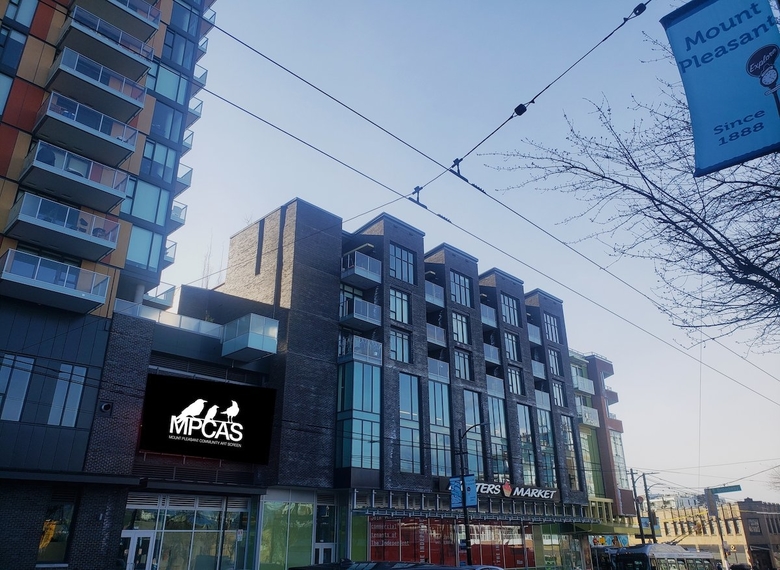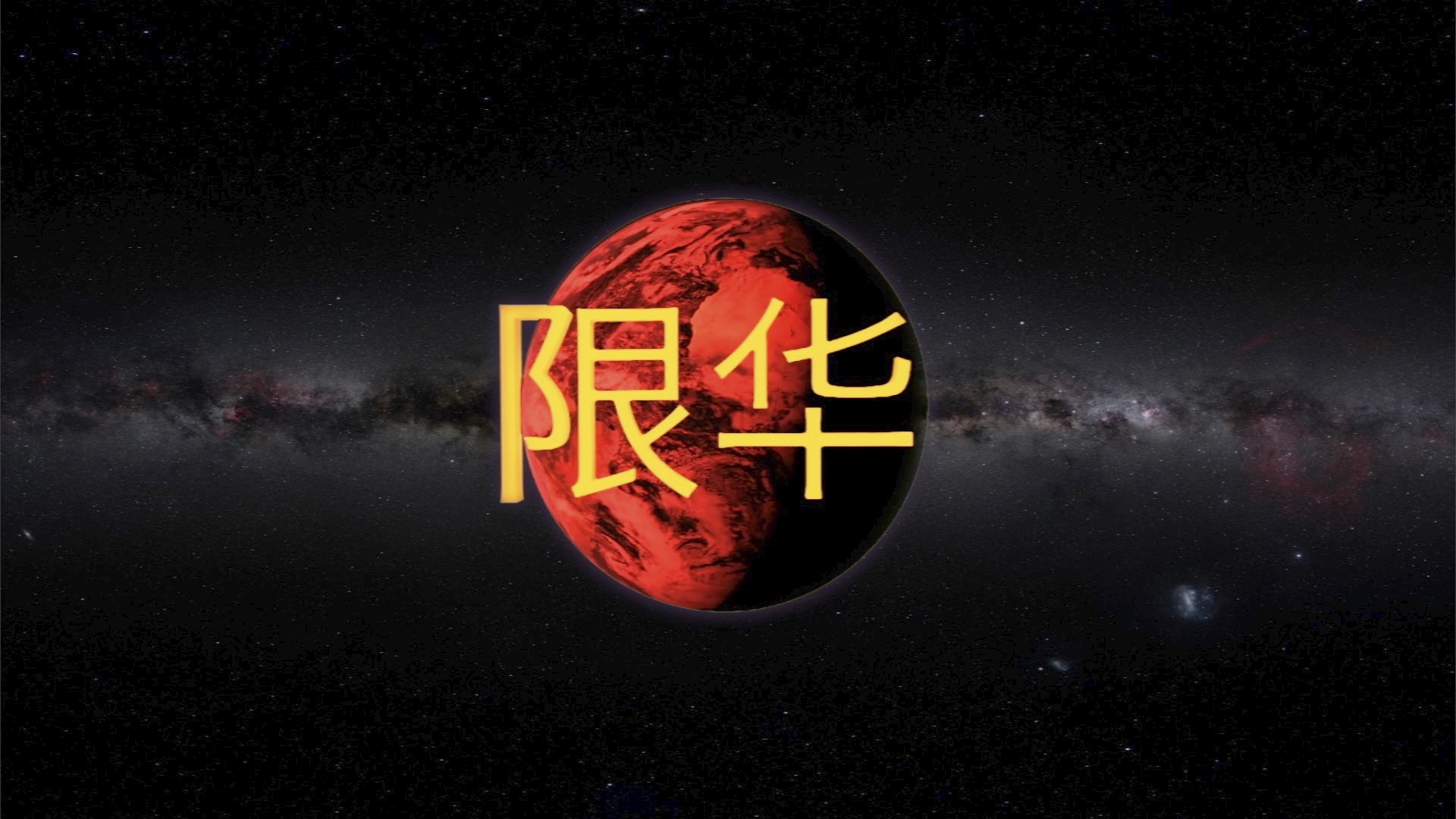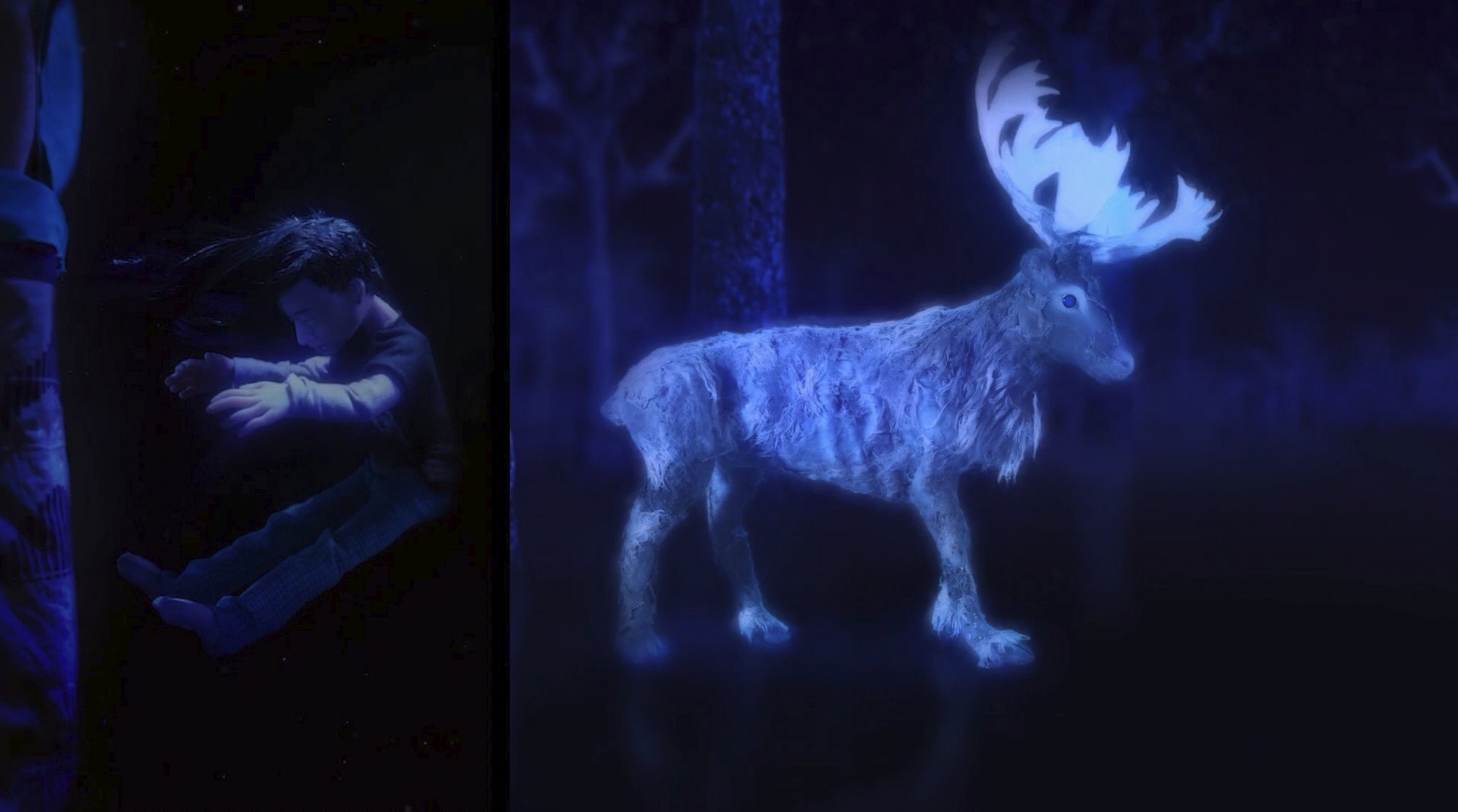At the intersection of Broadway and Kingsway in the heart of Vancouver’s Mount Pleasant neighbourhood a new urban screen for media art has been developed. Programmed through the artist-run-centre grunt gallery and supported through the City of Vancouver’s Public Art program, the seven by four feet metre LED screen is located on the side of a new condominium development called The Independent. Operating twelve hours a day, seven days a week, the Mount Pleasant Community Art Screen (MPCAS) features a collection of over forty media art works from local and Canadian artists as well as neighbourhood residents who have been invited to participate through artist and curator Lorna Boshman’s Digital Stories workshops.1
The urban screen sits on the unceded, traditional territories of the Coast Salish peoples sḵwx̱wú7mesh (Squamish), sel̓íl̓witulh (Tsleil-Waututh), and xʷməθkʷəy̓əm (Musqueam) nations. Traditionally Kingsway followed the Indigenous trail used by Canada's first peoples for hundreds of years. Today, Kingsway Street connects Vancouver with Burnaby.
“If grunt gallery did not put the whole idea into perspective, grunt would also be pushed out of the neighbourhood.”
The idea for a new screen began in 2014 when a City of Vancouver public art consultant approached three artist-run centers in Mount Pleasant: grunt gallery, The Western Front, and VIVO Media Arts Centre to discuss the potential project. After much debate, grunt gallery was the only one to agree to curate the screen. The other two organizations declined citing gentrification and the displacement of many artists and artist spaces who have been pushed out of the neighbourhood by corporate interests as reasons for not participating in the project.
Glenn Alteen, former grunt gallery director, Vanessa Kwan, former curator (now director), Megan Kus, operations manager and archivist Dan Pon decided to move forward with the project for several reasons, but mostly for survival. Not just the survival of the gallery itself but also for the survival of the remaining artist community in the neighbourhood. Alteen states, “If grunt gallery did not put the whole idea into perspective, grunt would also be pushed out of the neighbourhood.”2
The location of the media art screen leads to a series of questions that are difficult to answer. What does it mean to situate an urban art screen on a controversial condominium development amidst the gentrification of one of Vancouver’s oldest working-class neighbourhood’s situated on stolen land? Is it even possible to open up a space for ideas and dialogue about community in such controversial space?
The Wretched of the Screen, a 2012 collection of writings by German artist Hito Steryerl, is a good source to turn to for help working through these difficult questions. In her essay, “A Thing Like You and Me”, Steryerl talks about the rise in digital culture and the paradigm shift from “the politics of representation” to “the representation of politics”, from a culture of thinking about representation as who gets to be seen and who is left out.3 She discusses culture where iconic imagery is mass-produced and then re-produced, where images become a “thing” with the ability to breakdown the binary code between subject and object, a thing that is mass-produced, multilayered, complex, active, often dangerous and sometimes magical. Images as a thing in contemporary digital culture are agents in the understanding of the potential transformations of everyday life.4 Steryerl argues that image culture has the possibility for authentic, multi-layered perspectives that could be subverted through 21st century technologies including the urban screen.
Three videos from the MPCAS speak to what it is to participate in 21st century image culture with artists who work through ideas around race, gender, sex, and decolonization. Kevin Lee Burton’s HOMe (2019), Paul Wong’s CHINESE ONLY Television Bumpers (2019) and Amanda Strong’s Ghosts (2019) were commissioned by grunt gallery for its inaugural program titled PLACE that was meant to highlight experiences around the rapidly changing Mount Pleasant neighbourhood.
HOMe is a four minute experimental video connecting the homoerotic with the land. Burton explores gay identity, Indigeneity, and rural living through images taken on his ancestral territory of God’s Lake Narrows, Manitoba. In the work, he is situated both at home on his living room couch, and outdoors on reserve. The video moves between sexy, campy, fetishized images of him standing partially naked in front of a bonfire, peering alluringly through a fence, wearing only a jacket and pair of underwear while hunting. He kneels defiantly on the dirt with water from his water bottle spilling everywhere, or provocatively posing on a rock. These photographs are juxtaposed with images of him at home, gazing steadfast at the camera confronting the viewer as if to ask, “What do you see?“ The words, HOME and HOMO are inserted into this video and move across the screen anchoring his photographs and text into images of sexuality, place and land. Burton states, “My greatest goal is to create a fluid connection between traditional and technological ideas. Then we can start creating from self-expression rather than self-definition.”5
"He creates a series of larger-than-life self-portraits about 2Spirit, Indigenous queer identity, an experience that is central to any consideration of place."
As Steryerl explains, “Senses and things, abstraction and excitement, speculation and power, desire, and matter actually converge within images.”6 Burton’s work breaks down the binary between subject and object. He opens up a space for lived experience and storytelling, speaking one’s truth instead of trying to fit into restrictive categories and false narratives that repeat the homophobic and race-based violence that is so prevalent in today’s commercial urban screen culture.
Burton’s video, HOMe, subverts outdated ideas around colonial masculinity and its relation to Indigenous identity by transforming urban screen culture into a place where Indigenous culture and gay sexuality are visible and positively at play and even desired. He creates a series of larger-than-life self-portraits about 2Spirit, Indigenous queer identity, an experience that is central to any consideration of place.
Vancouver artist Paul Wong, created six short 10-second videos titled, CHINESE ONLY Television Bumpers. These brightly colored digital graphics are written specifically in Chinese characters. The characters, “Chinese Only” are overlaid onto other graphics such as images of the Earth or a sunset. For example, in one video the Chinese characters for “Chinese Only” circulates over a red Earth. In another they are overlaid on the colours of a sunset. In the third video, they are written in black on a white background. Only in one video is “Chinese Only” written in English, using an old-school film countdown icon as a backdrop for “Chinese Only” to scroll across the screen.
Vancouver has witnessed an overwhelming increase in anti-Asian hate crimes since the outbreak of the COVID-19 virus. Although these video graphics were created months before the pandemic, Wong addresses the politics of race centering the conversation around Vancouver’s violent exclusion of Chinese people and offers a warning about our past and the traumatic outcomes of racial discrimination. As Wong describes it, the “Chinese Only” characters can also be interpreted as “Chinese Exclusion.”7 The characters are very similar to the Chinese characters that were used in Canada’s historical exclusion of Chinese people.8 During this era Chinese Canadians were not allowed to vote, faced housing segregation and subsequently faced job discrimination.9 Immigration laws made it extremely difficult for Chinese people to come to Canada and upon enter to Canada, they were obligated to pay a Head Tax, a money grab that forced many families to live apart.
"Vancouver has witnessed an overwhelming increase in anti-Asian hate crimes since the outbreak of the COVID-19 virus."
As Steyerl reminds us, to participate in image culture means to take part in its violent history, a history that is often re-created through 21st century technology without question. Wong disrupts contemporary image culture by bringing anti-racist perspectives to the urban screen. Wong’s “CHINESE ONLY Television Bumpers” graphics directly reference signs used during the 1800’s up until the mid-20th century when the Canadian government blatantly refused Chinese people entry into Canada, and restricted people’s human rights upon arrival.10
Through the displacement, or reclamation of historic signs Wong shifts the notion of place to include the politics of race. These 10-second “CHINESE ONLY Television Bumpers” were designed as inserts into the PLACE programming in order to disrupt the traditional space of capitalism and white supremacy ideology.
In Amanda Strong’s work the idea of place is explored through a six-minute, stop-motion animation titled Ghosts. It’s a story about the plight of the wolf and the caribou that have been pushed out of their natural habitats, forcibly removed and facing extinction in parts of Canada. Amanda Strong states, “Ghost Caribou, Ghost Wolf and ancestors act as reminders of what exists in this world and provide lessons about honesty, humility and working for the people. In this short, stop-motion animation experiment time will freeze and warp. We see echoes from the past, but we remain steadfast in the present. The neighbourhood acts as both a settler compound and Indigenous space.”11
In Strong’s video decolonial politics are centralized through the shifting and changing notion of place with its central character embodying the past, present, and future and collapsing the binary oppositions between capitalism and community.12 By placing at its center a new type of protagonist, Ghosts’ indigenizes the urban screen by offering viewers images of place as a fluid and ever changing phenomenon.
As Steyerl suggests, when an image becomes a thing the myth of the hero crumbles.13 In Ghosts, we experience a new anti-hero, a non-binary, Indigenous specter, an unorthodox time traveler and shape-shifter that defies the laws of space and time, disobeys notions of capitalist ownership and refuses to put individualistic gain over the rights of the land.
The three commissioned artists in the MPCAS’s inaugural program consider the instability of place. For Burton, it is the coming together of gay desire and Indigeneity: a breaking down of the binary codes around sex and gender that disrupts hetronorativity in settler colonial culture. In Wong’s videos, he uses images of anti-Asian violence and re-imagines the Chinese characters as word plays that emphasize the role language itself has in destabilizing racial divides. Whereas, Ghosts’ illustrates the impacts of settler colonization on Indigenous people, the animals, the territory, and on spirituality. Strong’s animation destabilizes the notion of place as both static and one-dimensional and opens up space for multiple perspectives that extend post-colonial thought.
Placing an urban screen in the heart of a neighbourhood faced with the challenges of gentrification can be seen as an act of making space for the potential of media art and visual culture to inspire dialogue and foster healthy communities. To situate an art-only screen on a controversial condominium disrupts the consumer paradigm we so often associate with urban screen culture. The works of Burton, Wong, and Strong are effective in subverting the business-as-usual platform of the urban screen by making the Mount Pleasant Community Art Screen an important conduit for underrepresented perspectives and in making the invisible visible.
The three commissioned works, HOMe, CHINESE ONLY and Ghosts will be on view into 2021. The program PLACE screens throughout 2021 including seventeen new media works selected for the program including a recently commissioned work by Charlene Vickers, titled Cool Indians on Main Street. Vancouver artists Vickers and Neil Eustache are the co-founders of Cool Indians on Main Street benchin collective and they have invited several Indigenous artists to make an open-ended statements about Indigenous presence and the action of bench-sitting or “benchin.”14
MPCAS Hours: Sunday to Thursday: 9:00 AM to 9:30 PM & Friday and Saturday: 9:00 AM to 10:30 PM.
You can also follow the programming at http://www.mpcas.ca & https://grunt.ca/mount-pleasant-community-art-screen/.






